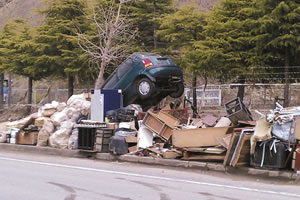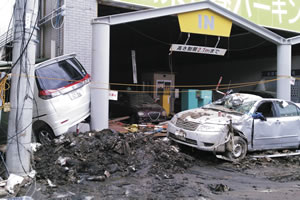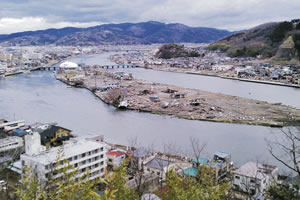Stories Of Hope And Resilience

The city of Ishinomaki was devastated. Ron Mizutani photos
Each week I’m blessed with the opportunity to share stories about our beautiful ocean and the people who consider it their playground. I often tap into images of the sea when life gets to be “too much,” and those visual pictures are usually enough to release worries and ease my mind.
But recently I was humbly reminded about how powerful and destructive the ocean can be. I was on assignment in Japan covering the earthquake and tsunami that killed thousands of people March 11.
Photographer Greg Lau and I were nervous when we arrived in Tokyo knowing we would soon be standing in an area we had only seen on television. We arrived at our hotel just after midnight and after a two-hour power nap, we started the long seven-hour car ride to Ishinomaki, one of the hardest hit areas in Miyagi prefecture.

Ishinomaki destruction
Local boy Ryoji Soranaka of Aiea, who now owns a popular Hawaiian food restaurant in Akasaka, agreed to drive us north to the tsunami-torn land. Like others in Japan, Soranaka and his family experienced the 9.1 earthquake and had endured hundreds of aftershocks since the initial jolt. Soranaka wanted to see the destruction “with his own eyes.”
The drive took us by Fukushima just outside the evacuation zone of the Dai-ichi nuclear power plant. We didn’t stop.
Two hours later we entered Sendai and my heart started racing when I realized what highway we were traveling on. It was the same stretch of road I saw on television March 11. I remember watching in horror as hundreds of residents attempted to flee in their vehicles, only to be swallowed up by a massive black wall of moving water. The scarred land was still littered with mountains of metal and destroyed homes. We knew it was about to get uglier.
We arrived in Ishinomaki about an hour later. I took a deep breath as we turned the corner but I was not prepared for what was before me. You often hear the cliché, “You have to see it to believe it.” Well, I was seeing it but I still couldn’t believe it.
Entire communities near the Kitakami River and the Port of Ishinomaki were washed away. Kazu and Kaori Aizawa described watching helplessly from their home as a tsunami estimated to be about 32-feet high roared toward them, destroying everything in its path. The Aizawas watched people die that afternoon including some of their neighbors but for some reason their lives were spared. They were finding survivor guilt difficult to deal with.

Entire communities near the Kitakami River were washed away
City officials say 50 percent of the city was inundated by the tsunami and more than 2,800 people were killed. An estimated 2,700 are still missing. One school suffered tremendous losses.
Seventy-four of the 108 students and 10 of the 13 teachers at Okawa Elementary were killed.
As we approached Ishinomaki Bay I stared at the ocean. It looked so beautiful and calm. I tried to visualize what the black wave of debris might have looked like as it moved inland. I could not.
But there was no doubt what the mountain of water left behind. The metal from thousands of vehicles and hundreds of boats was already beginning to rust. Cleanup crews had cleared many roads, pushing debris into hundreds of piles, some 40-feet high.
Despite the incredible destruction, we were amazed by the people’s resilience and fighting spirit. They worked like bees. Their faces told stories of pain and exhaustion, yet their bodies never stopped moving. They smiled as we gathered our pictures to bring home to Hawaii. I wanted to cry for these men and women.
It was a moment I will never forget.
For more on our life-changing trip to northeastern Japan, tune into KHON2 News each Thursday night in the month of May. And on May 24, join us for a 30-minute special titled Japan’s Recovery: Stories of hope, stories of resilience.



